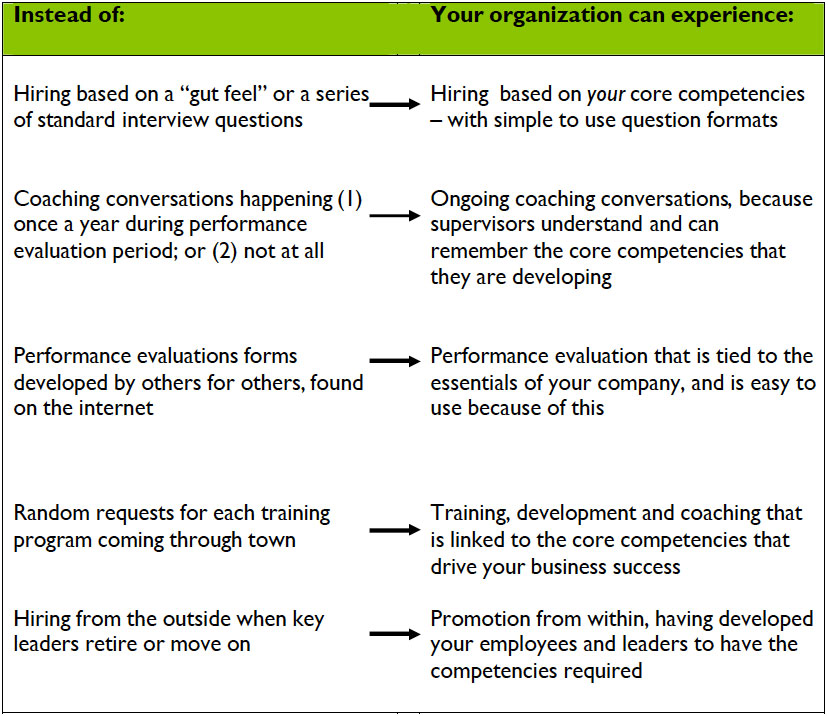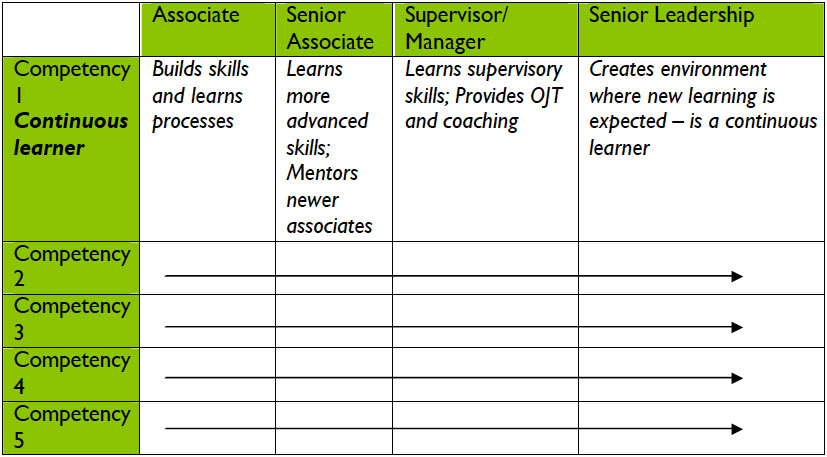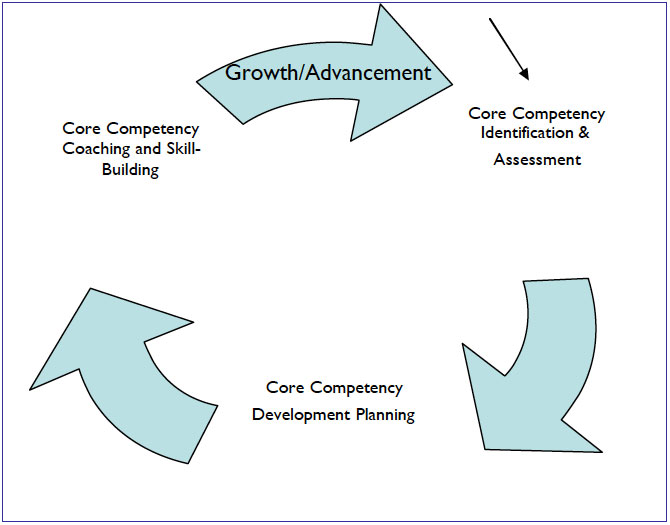We recommend starting with a Core competency model, identifying only the top 5-6 key competencies that drive your organization’s success. A Core competency model provides you with much of the benefit of more complex and more expensive competency model architecture, but with an ease of use and simplicity that will help ensure the model is used.
Core Competency Models
- Provide consistent language and terms for describing some of the intangible behaviors that can lead to success or in their absence, derail your top producers
- Identify successful behaviors at different organizational levels – associates can see a progression of the needed characteristics
- Make clear that it is unacceptable to simply meet or exceed production/sales/financial goals, without demonstrating the organization’s core competencies
Much of the literature on competency models tends to complicate the issue, indicating that you will need sophisticated IT solutions to manage your competency models and their applications. Nothing is further from the truth, and in fact, the more streamlined your core competency model is to the absolute essentials for employee success, the greater use it will have. Countless overly sophisticated competency models are sitting unused in computer files and on shelves, having exhausted their HR staffs and line leadership long before full implementation.
“So – tell me again, why does my organization need a competency model?”
Perhaps the main reason is that competency models send the message that there are clearly defined boundaries for successful behavior at your company. It’s not OK to “take the hill” and not be concerned with how you do it. Your company stands for certain things, and these characteristics will become part of your core competency model.
“It sounds like a lot of organizations get this wrong – what does it look like when it’s done right?”
Characteristics of effective core competency models:
- Aligned with the business, reinforcing organizational values
- Succinct, memorable
- Practical for line managers and front-line supervisors to use as a coaching tool
- Foundation for human resources management processes
“My company needs skilled workers – not people with just this soft stuff.”
Of course you do. But…it’s not an either/or situation. Top organizations see the technical skills and core competencies as baseline – you need BOTH to be successful. You need both the WHAT (technical skills to produce the service/product) and the HOW it is to be performed (core competencies.)
“It sounds like we should have had a competency model at start-up – it’s a little late for that”
Organizations can initiate core competency models at any time.
Having a core competency model at start-up is ideal, because all of your hiring and onboarding will assess and reinforce the core competencies. But anytime is really fine for identification of the core competency model.
Core competency models are often needed (or may need to be fine-tuned) during times of:
- Significant organizational change – you want to emphasize the new behaviors that will be needed for success.
- Company growth, when a core competency model defines for all the behaviors that have helped create the success. It takes the mystery out of the process, and lets all associates know the path to success.
- Turnaround – i.e. we are turning away from our old behaviors, and towards these behaviors identified in the core competency model.
“We’re a small organization with limited HR support – is this really practical for us?”
What could be more practical – a concise, easy to use tool that is the “glue” for all of your human resources practices?

A core competency model is simply the picture of successful behavior at your organization.
A streamlined core competency model might look like the diagram below:

“I’ve seen competency models that are pages and pages for a single job. How does your approach fit in?”
For many jobs in your organization, the core competency model may be the only behavioral competency model needed. For example, non-management positions and first line supervisors may be perfectly successful by simply demonstrating the core competencies.
Some positions, however, will need additional behavioral competencies for success. A sales position, for example, will need persuasion, negotiation, influencing, and other behaviors to be successful. Additional competencies for specific positions (Sales) or roles (Senior Management) can be developed in addition to your core competency model, as you have the time and need to identify them.
“OK, once we have a core competency model, what will we do with it?”
Let’s think about that associate level employee throughout the entire employee lifecycle.
- Our core competency model is first used to hire this employee. Based on the Continuous learning competency identified above, one of our interview questions is “Tell us about a time when you learned a new skill. What got you started? How did you go about it? How did it turn out?” This helps the hiring manager determine if this person is a good fit for the organization – have they demonstrated the core competency?
- Our employee is now on-board. The supervisor uses the Associate level core competency model (just 5-6 brief statements defining success) to explain to the employee what the expectations are for all employees here. The core competency model creates a consistent platform for all on-boarding conversations. No more are managers just “winging it” in their initial Day One conversations.
- The supervisor uses the Associate core competency model as a coaching guide – how well is the employee doing relative to the identified behaviors. When the supervisor coaches the employee, they are both referring back to the core competency model. The model takes some of the awkwardness out of the coaching conversation – it provides the standard for measurement and for skill-building. The feedback is not simply a matter of the supervisor’s perceptions and feelings, but a gauge against the core competency model standard.
- The supervisor uses the periodic coaching guides and his/her notes to document annual job performance. In addition to meeting certain work goals, how the employee performs on the core competencies is important.
- After a period of assessment, the supervisor and employee are aware of the employee’s strengths and weaknesses relative to the core competency model. They can agree on a process for building on strengths and developing areas for improvement.
- After the employee has mastery of the core competencies at the Associate level, the employee can look towards the next level, and begin developing the skills at the Senior Associate level.
- When a Senior Associate level position comes open, our Associate is ready for advancement.

“All right – I’m convinced. How do I get started?”
The first step is to determine if you have the skills and time to develop the core competency model internally. A resource skillful in streamlined competency model development and deployment will be able to jumpstart your efforts, and provide you with useable HR tools within a very short timeframe.
Once you have determined the resources for the task, the steps are as follows:
- Identify the core competencies. Work the list until you have as few as possible that really speak to who you are (or want to be) as an organization.
- Determine the number of levels within your organization. Is it just two – staff and management? Is it four – similar to the example we’ve used?
- Describe the core competencies at each organizational level.
- Develop simple to use coaching tools, hiring guides, performance evaluations, and learning plans to support the assessment and development of the core competencies.
- Overcommunicate the core competency model within the organization.
- Use the tools with employees at all organizational levels.
- Use the core competency language in meetings, employee talks, etc.
- Recognize, reward and promote associates demonstrating the core competencies.
